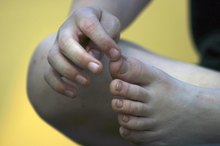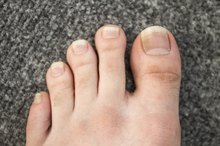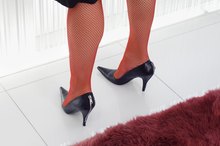How to Decrease the Swelling With an Infected Toe
Toe infections are typically accompanied by pain, redness, warmth and swelling, and can be severe enough to interfere with walking and wearing shoes. These infections can be related to an injury, ingrown toenail or blister, and if allowed to spread, can lead to a serious infection of the bone, surrounding tissue or blood. Depending on your health and the severity of the infection and swelling, you may require antibiotics or more aggressive treatment. Swelling associated with minor infections, however, may be treatable at home.
Get Medical Advice
If you have diabetes or have been told you have peripheral artery disease (PAD) -- which leads to poor blood flow to the feet, your toe infection may not heal well and can be more likely to spread to the surrounding tissue or bone. So it's important to see your doctor or podiatrist at the first sign of an infected toe. Your doctor can then determine a treatment plan for you, which includes home care steps. If you are healthy without any history of diabetes or PAD, and you have a minor infection with swelling of the toe, home treatment may be all you need to get your toe back to health again.
Soak in Warm Water
How to Soak an Infected Toe
Learn More
Home treatment for a toe infection involves applying moist heat, which may not initially reduce swelling but can help improve blood flow, decrease pain and hasten healing 2. Soak the foot in warm -- not hot -- water for 15 minutes, 3 to 4 times daily. Adding 1 to 2 tablespoons of Epsom salt per quart of water is acceptable, but not necessary for relief. Alternatively, apply a warm, damp washcloth to the toe. Keep the foot dry the rest of the day.
Treat the Infection
Ask your doctor about the use of antibiotics for the management of your swelling and infection. Most commonly, doctors recommend topical antibiotic ointment, which can be applied after soaking and before applying a clean bandage to the infected area. Oral antibiotics, or less commonly, intravenous antibiotics, may also be prescribed to treat the infection.
Elevate the Foot
How to Treat Bruised Toenails
Learn More
Take time to elevate your foot and toe when sitting and sleeping. This practice makes it easier for blood to return from the legs to the heart and helps prevent fluid from being stagnant in the feet -- which reduces swelling. Elevate your foot for 30 minutes at a time, several times daily. Also, stay off your feet as much as possible, since walking on your toe can worsen swelling and delay healing.
Relieve the Pain
For relief of pain, an over-the-counter (OTC) anti-inflammatory drug such as ibuprofen (Advil) or naproxen (Aleve) may be recommended to alleviate inflammation and swelling. While acetaminophen (Tylenol) is not anti-inflammatory, it is an alternative to OTC pain management. Prescription-strength anti-inflammatory medications are also available. If you are under a doctor's care for any medical condition, ask your doctor about the best choice of pain reliever for you.
Tips
Protect your toe while it heals. Wear comfortable shoes with wiggle room for the toes. If you can't wear your normal shoes due to the swelling or pain, talk to your doctor to discuss foot protection options.
Warnings
If you have an infected toe and you also have diabetes, PAD or any other condition that affects blood circulation or compromises your immune system, contact your doctor right away. Also call your doctor for an immediate appointment if you develop a fever, or if you have signs of a worsening infection, such as increased redness, swelling, pain or discharge. Other symptoms that warrant urgent medical attention include chills, nausea and red streaks running outward from the injury site.
Reviewed by Kay Peck, MPH RD
Related Articles
References
Writer Bio
Sandra Ketcham has nearly two decades of experience writing and editing for major websites and magazines. Her work appears in numerous web and print publications, including "The Atlanta Journal-Constitution," "The Tampa Bay Times," Visit Florida, "USA Today," AOL's Gadling and "Kraze Magazine."








